Collaborative play across ages or generations requires a certain familiarity with the play activity, plus an ability to read the intentions of the other player.

A somewhat younger boy in the left foreground waits for the water to flow his way now that the older boys have closed the gap between the blocks.

A father and son work together to build an arch of arches.
What It Means
True collaboration is more than,“I wait, you build, I use.” Parents are sometimes at a loss on how to motivate or co-play with their children. They don’t want to be too directive, but they do want to feel that this time off from work will be remembered as a fun time together, not just a fun time for the child. The decision regarding what to do can determine the success.
Children of Different Ages
Cross-age play with two-year-olds and four-year-olds will be very different from fours with sevens. For twos with fours, both ages are new to building and you might see positive play. The play may be as simple as the four-year-old building while the two-year-old knocks down. If the four-year- old approves, such play can be fun and can give rise to interesting strategies, such as making the structure harder for the two-year-old to knock down. Sevens are often too impatient to deal with the interests of the fours. At seven, children are intent on mastery and achievement, as well as maintaining a strong affiliation with their peers. In many instances, the best play will occur when the fours and the sevens play in parallel in their own way.
Of course, if the play is between siblings of different ages, there will be more helping from older to younger. For older children, there is sometimes systematic helping of younger children, particularly from the older girls. Attempts by older children to support the younger children are an extremely positive sign of social development.
This material is adapted from the publication “Imagination Playground’s Guidance to Play” by George E. Forman, PhD, Emeritus Professor, University of Massachusetts (Amherst) and President of Videatives, Inc.
Dr. Forman has over 33 years of experience in university teaching, cognitive research, multimedia design and educational consulting in the area of early childhood learning and development.
“Guidance to Play” covers 20 topics that help illustrate the significance in what children are doing as they play as well as concrete actions Play Associates can take to facilitate positive behaviors.



